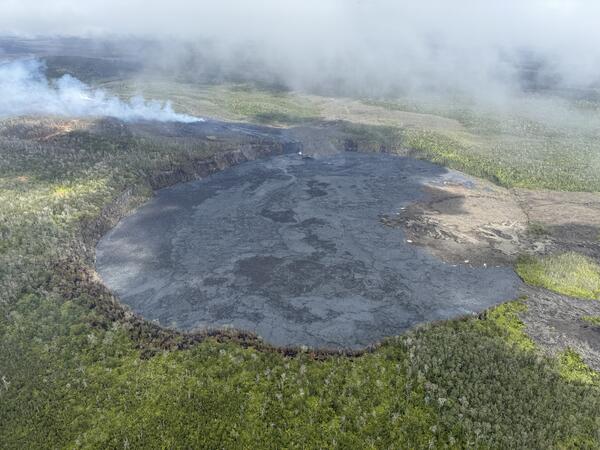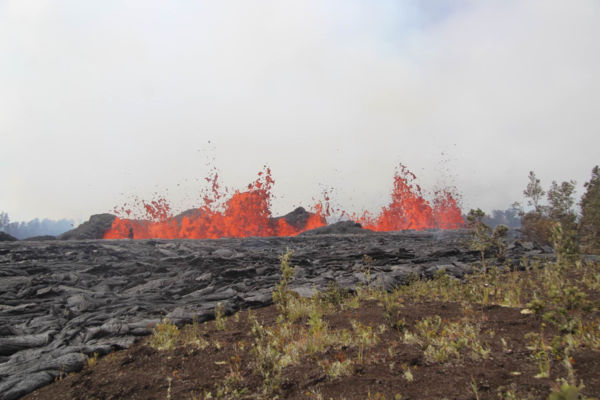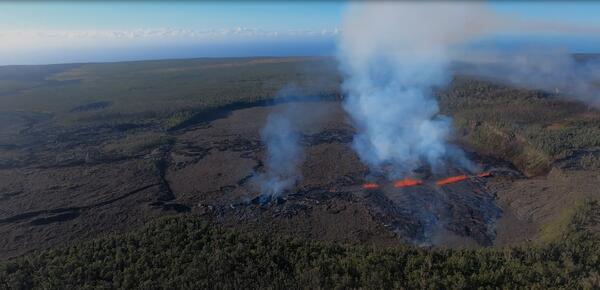In this episode of Eyes on Earth, we talk to forest ecologist Jim Lutz about the effort to map fires in Utah. Fire research in the West is dominated by the study of large fires, but the forests in Utah are different. Utah typically does not have a lot of large fires as other western states do.
All Multimedia
Access all multimedia to include images, video, audio, webcams, before-after imagery, and more. Filter and explore with filtering options to refine search.


In this episode of Eyes on Earth, we talk to forest ecologist Jim Lutz about the effort to map fires in Utah. Fire research in the West is dominated by the study of large fires, but the forests in Utah are different. Utah typically does not have a lot of large fires as other western states do.
 Color photograph of newly erupted lava and fume in the background
Color photograph of newly erupted lava and fume in the background
September 19, 2024—New lava flows on the middle East Rift Zone of Kīlauea
September 19, 2024—New lava flows on the middle East Rift Zone of KīlaueaOn September 19, 2024, USGS-Hawaiian Volcano Observatory geologists landed near the Kīlauea middle East Rift Zone eruption site, where they viewed lava flowing through a channel more than 50 meters (about 164 feet) wide.
September 19, 2024—New lava flows on the middle East Rift Zone of Kīlauea
September 19, 2024—New lava flows on the middle East Rift Zone of KīlaueaOn September 19, 2024, USGS-Hawaiian Volcano Observatory geologists landed near the Kīlauea middle East Rift Zone eruption site, where they viewed lava flowing through a channel more than 50 meters (about 164 feet) wide.
 Color photograph of eruption with white words
Color photograph of eruption with white words
September 20, 2024 —Kīlauea middle East Rift Zone eruption summary
September 20, 2024 —Kīlauea middle East Rift Zone eruption summaryOn the night of September 15, USGS Hawaiian Volcano Observatory geophysical data indicated that an eruption could be occurring a remote area of Kīlauea’s middle East Rift Zone, within Hawaiʻi Volcanoes National Park.
September 20, 2024 —Kīlauea middle East Rift Zone eruption summary
September 20, 2024 —Kīlauea middle East Rift Zone eruption summaryOn the night of September 15, USGS Hawaiian Volcano Observatory geophysical data indicated that an eruption could be occurring a remote area of Kīlauea’s middle East Rift Zone, within Hawaiʻi Volcanoes National Park.
 Color photograph showing aerial view of crater floor that is mostly covered with black fresh lava
Color photograph showing aerial view of crater floor that is mostly covered with black fresh lava
September 20, 2024—Kīlauea middle East Rift Zone eruption overflight and ground views
September 20, 2024—Kīlauea middle East Rift Zone eruption overflight and ground viewsUSGS Hawaiian Volcano Observatory field monitoring crews captured these videos during their visit to Kīlauea middle East Rift Zone eruption site the morning of September 20, 2024. They reported minor spattering and small fountains at one end of the vent at 8:30 a.m. HST. By 10 a.m.
September 20, 2024—Kīlauea middle East Rift Zone eruption overflight and ground views
September 20, 2024—Kīlauea middle East Rift Zone eruption overflight and ground viewsUSGS Hawaiian Volcano Observatory field monitoring crews captured these videos during their visit to Kīlauea middle East Rift Zone eruption site the morning of September 20, 2024. They reported minor spattering and small fountains at one end of the vent at 8:30 a.m. HST. By 10 a.m.
 Helicopter photo of lava erupting from a cluster of fissures. Lava flows in a river away from the viewer over a crater rim.
Helicopter photo of lava erupting from a cluster of fissures. Lava flows in a river away from the viewer over a crater rim.
September 19, 2024 — Kīlauea middle East Rift Zone eruption overflight
September 19, 2024 — Kīlauea middle East Rift Zone eruption overflightUSGS Hawaiian Volcano Observatory geologists conducted a reconnaissance overflight of the eruption near Nāpau Crater on the middle East Rift Zone of Kīlauea. They observed lava cascading over the rim of the crater from a channel more than 50 meters (about 164 feet) wide.
September 19, 2024 — Kīlauea middle East Rift Zone eruption overflight
September 19, 2024 — Kīlauea middle East Rift Zone eruption overflightUSGS Hawaiian Volcano Observatory geologists conducted a reconnaissance overflight of the eruption near Nāpau Crater on the middle East Rift Zone of Kīlauea. They observed lava cascading over the rim of the crater from a channel more than 50 meters (about 164 feet) wide.
 A curtain of molten lava erupting from a line of fissures sits behind a field of glossy black new lava flows
A curtain of molten lava erupting from a line of fissures sits behind a field of glossy black new lava flows
September 19, 2024 —Kīlauea lava fountains erupting
September 19, 2024 —Kīlauea lava fountains eruptingOn September 19, USGS Hawaiian Volcano Observatory geologists were able to capture this video of the fissure vent eruption west of Nāpau Crater on the middle East Rift Zone of Kīlauea. They observed a 150-m-long (nearly 500 feet) fissure west of the crater erupting lava in a curtain of lava 10-20 meters (33-66 feet) high.
September 19, 2024 —Kīlauea lava fountains erupting
September 19, 2024 —Kīlauea lava fountains eruptingOn September 19, USGS Hawaiian Volcano Observatory geologists were able to capture this video of the fissure vent eruption west of Nāpau Crater on the middle East Rift Zone of Kīlauea. They observed a 150-m-long (nearly 500 feet) fissure west of the crater erupting lava in a curtain of lava 10-20 meters (33-66 feet) high.
 Color photograph of eruption in crater
Color photograph of eruption in crater
September 17, 2024 —Kīlauea middle East Rift Zone eruption overflight
September 17, 2024 —Kīlauea middle East Rift Zone eruption overflightKīlauea volcano is erupting in Hawai’i Volcanoes National Park from a new fissure vent that opened within Nāpau Crater this morning, September 17, between 4:00 and 5:00 AM HST. The eruption is occurring within a closed and remote area of Hawaiʻi Volcanoes National Park.
September 17, 2024 —Kīlauea middle East Rift Zone eruption overflight
September 17, 2024 —Kīlauea middle East Rift Zone eruption overflightKīlauea volcano is erupting in Hawai’i Volcanoes National Park from a new fissure vent that opened within Nāpau Crater this morning, September 17, between 4:00 and 5:00 AM HST. The eruption is occurring within a closed and remote area of Hawaiʻi Volcanoes National Park.
 Color photograph of scientist near lava flow
Color photograph of scientist near lava flow
September 17, 2024 —Kīlauea middle East Rift Zone eruption sampling
September 17, 2024 —Kīlauea middle East Rift Zone eruption samplingUSGS Hawaiian Volcano Observatory geologists collected a sample of the middle East Rift Zone Kīlauea eruption in Nāpau Crater, within a closed area Hawaiʻi Volcanoes National Park. Geologists put molten lava into a metal bucket and rapidly quench it with water.
September 17, 2024 —Kīlauea middle East Rift Zone eruption sampling
September 17, 2024 —Kīlauea middle East Rift Zone eruption samplingUSGS Hawaiian Volcano Observatory geologists collected a sample of the middle East Rift Zone Kīlauea eruption in Nāpau Crater, within a closed area Hawaiʻi Volcanoes National Park. Geologists put molten lava into a metal bucket and rapidly quench it with water.
 Color photograph of eruption site
Color photograph of eruption site
September 16, 2024 — Overflight video of eruption site near Nāpau Crater, Kīlauea
September 16, 2024 — Overflight video of eruption site near Nāpau Crater, KīlaueaA brief, small eruption occurred on the middle East Rift Zone of Kīlauea late on September 15. The eruption produced two small pads of lava just west of Nāpau Crater, which is west (uprift) of the former Pu‘u‘ō‘ō eruption site.
September 16, 2024 — Overflight video of eruption site near Nāpau Crater, Kīlauea
September 16, 2024 — Overflight video of eruption site near Nāpau Crater, KīlaueaA brief, small eruption occurred on the middle East Rift Zone of Kīlauea late on September 15. The eruption produced two small pads of lava just west of Nāpau Crater, which is west (uprift) of the former Pu‘u‘ō‘ō eruption site.
 Color photograph of volcanic crater surrounded by forest and a fissure emitting volcanic gas
Color photograph of volcanic crater surrounded by forest and a fissure emitting volcanic gas
September 16, 2024 —Kīlauea middle East Rift Zone eruption overflight
September 16, 2024 —Kīlauea middle East Rift Zone eruption overflightThis video, taken during a Hawaiian Volcano Observatory morning overflight of Kīlaueaʻs middle East Rift Zone on September 16, 2024, shows new lava flows erupted over about an hour during the evening on September 15, 2024.
September 16, 2024 —Kīlauea middle East Rift Zone eruption overflight
September 16, 2024 —Kīlauea middle East Rift Zone eruption overflightThis video, taken during a Hawaiian Volcano Observatory morning overflight of Kīlaueaʻs middle East Rift Zone on September 16, 2024, shows new lava flows erupted over about an hour during the evening on September 15, 2024.
 Looking down from a helicopter, this photo shows charred and brown trees surrounded by a new, steaming lava flow.
Looking down from a helicopter, this photo shows charred and brown trees surrounded by a new, steaming lava flow.
September 16, 2024—Brief eruption near Nāpau Crater on Kīlauea Middle East Rift Zone
September 16, 2024—Brief eruption near Nāpau Crater on Kīlauea Middle East Rift ZoneDuring a USGS Hawaiian Volcano Observatory overflight at approximately 10:30 a.m. HST on September 16, geologists observed freshly erupted lava west of Nāpau Crater on the remote middle East Rift Zone of Kīlauea, within Hawaiʻi Volcanoes National Park. This eruption likely occurred between approximately 9–10 p.m. HST on September 15.
September 16, 2024—Brief eruption near Nāpau Crater on Kīlauea Middle East Rift Zone
September 16, 2024—Brief eruption near Nāpau Crater on Kīlauea Middle East Rift ZoneDuring a USGS Hawaiian Volcano Observatory overflight at approximately 10:30 a.m. HST on September 16, geologists observed freshly erupted lava west of Nāpau Crater on the remote middle East Rift Zone of Kīlauea, within Hawaiʻi Volcanoes National Park. This eruption likely occurred between approximately 9–10 p.m. HST on September 15.
Sounds from a large herd of walruses resting on Alaskan shores of the Chukchi Sea recorded. Deep full barks and calls of individual walruses near the edge of the herd are audible over a continuous rhythmic humming sound that arises from the calls of tens of thousands of walrsues from deeper within the herd.
Sounds from a large herd of walruses resting on Alaskan shores of the Chukchi Sea recorded. Deep full barks and calls of individual walruses near the edge of the herd are audible over a continuous rhythmic humming sound that arises from the calls of tens of thousands of walrsues from deeper within the herd.


This Eyes on Earth episode is the third in our series on using Landsat for coastal studies. We talk to physical geographer Jeff Danielson about bathymetry and how it is critical for coastal modeling. Bathymetry captures the shape of underwater topography, and satellite-derived bathymetry helps fill in areas where there are data gaps.
This Eyes on Earth episode is the third in our series on using Landsat for coastal studies. We talk to physical geographer Jeff Danielson about bathymetry and how it is critical for coastal modeling. Bathymetry captures the shape of underwater topography, and satellite-derived bathymetry helps fill in areas where there are data gaps.
 Is there oil in Yellowstone?
Is there oil in Yellowstone?
Is there oil in Yellowstone? (Yellowstone Monthly Update - September 2024)
Is there oil in Yellowstone? (Yellowstone Monthly Update - September 2024)Is it true that there's oil in Yellowstone? Watch this month's Yellowstone Monthly update and find out.
Is there oil in Yellowstone? (Yellowstone Monthly Update - September 2024)
Is there oil in Yellowstone? (Yellowstone Monthly Update - September 2024)Is it true that there's oil in Yellowstone? Watch this month's Yellowstone Monthly update and find out.
 A Statewide Hydraulic Modeling Tool for Stream Crossing Projects in Massachusetts Thumbnail
A Statewide Hydraulic Modeling Tool for Stream Crossing Projects in Massachusetts Thumbnail
A Statewide Hydraulic Modeling Tool for Stream Crossing Projects in Massachusetts
A Statewide Hydraulic Modeling Tool for Stream Crossing Projects in MassachusettsThe U.S. Geological Survey and the University of Massachusetts at Amherst (UMass Amherst), in cooperation with the Massachusetts Department of Environmental Protection (MassDEP), began a series of studies in 2019 to develop a web-based statewide hydraulic modeling tool to provide preliminary culvert designs for stream-crossing projects in Massachusetts.
A Statewide Hydraulic Modeling Tool for Stream Crossing Projects in Massachusetts
A Statewide Hydraulic Modeling Tool for Stream Crossing Projects in MassachusettsThe U.S. Geological Survey and the University of Massachusetts at Amherst (UMass Amherst), in cooperation with the Massachusetts Department of Environmental Protection (MassDEP), began a series of studies in 2019 to develop a web-based statewide hydraulic modeling tool to provide preliminary culvert designs for stream-crossing projects in Massachusetts.


In this episode of Eyes on Earth, we talked with some of the interns who worked at EROS this summer. They shared their experiences learning about the cloud, AI, wildland fire research, terrestrial lidar scanning, and more. The common theme among them was recognizing the value of the EROS mission and noticing the passion their co-workers demonstrated in their work.
In this episode of Eyes on Earth, we talked with some of the interns who worked at EROS this summer. They shared their experiences learning about the cloud, AI, wildland fire research, terrestrial lidar scanning, and more. The common theme among them was recognizing the value of the EROS mission and noticing the passion their co-workers demonstrated in their work.
 Illustration combining images of cracked bare ground and a satellite image, with text in various colors on top
Illustration combining images of cracked bare ground and a satellite image, with text in various colors on top
Landsat Captures Mexico's Trending Drought (Image of the Week)
Landsat Captures Mexico's Trending Drought (Image of the Week)Prolonged drought has lowered water levels in Laguna Bustillos in Chihuahua State, Mexico, killing thousands of fish.
Landsat Captures Mexico's Trending Drought (Image of the Week)
Landsat Captures Mexico's Trending Drought (Image of the Week)Prolonged drought has lowered water levels in Laguna Bustillos in Chihuahua State, Mexico, killing thousands of fish.
 Card: USGS Office of International Programs Kenya Groundwater Project
Card: USGS Office of International Programs Kenya Groundwater Project
USGS Office of International Programs Kenya Groundwater Project
USGS Office of International Programs Kenya Groundwater ProjectThis is an Office of International Programs (OIP) science highlight featuring groundwater remote sensing and optimizations in Kenya.
USGS Office of International Programs Kenya Groundwater Project
USGS Office of International Programs Kenya Groundwater ProjectThis is an Office of International Programs (OIP) science highlight featuring groundwater remote sensing and optimizations in Kenya.
 Update Biscuit Basin
Update Biscuit Basin
Biscuit Basin Update; 65th Anniversary — M7.3 Hebgen Lake Quake (Yellowstone Monthly Update - Aug 2024)
Biscuit Basin Update; 65th Anniversary — M7.3 Hebgen Lake Quake (Yellowstone Monthly Update - Aug 2024)In this month's video, we update you on the Biscuit Basin explosion on July 23, 2024, and discuss the 65th anniversary of the M7.3 Hegben Lake earthquake.
Biscuit Basin Update; 65th Anniversary — M7.3 Hebgen Lake Quake (Yellowstone Monthly Update - Aug 2024)
Biscuit Basin Update; 65th Anniversary — M7.3 Hebgen Lake Quake (Yellowstone Monthly Update - Aug 2024)In this month's video, we update you on the Biscuit Basin explosion on July 23, 2024, and discuss the 65th anniversary of the M7.3 Hegben Lake earthquake.
 Stream Crossings - Massachusetts Hydraulic Modeling Tool video thumbnail.
Stream Crossings - Massachusetts Hydraulic Modeling Tool video thumbnail.
Introducing the Massachusetts Statewide Hydraulic Modeling Tool
Introducing the Massachusetts Statewide Hydraulic Modeling ToolThe U.S. Geological Survey (USGS), in cooperation with the Massachusetts Department of Environmental Protection and the University of Massachusetts at Amherst, have developed a GIS-based hydraulic modeling tool for Massachusetts stream crossing replacement projects.
Introducing the Massachusetts Statewide Hydraulic Modeling Tool
Introducing the Massachusetts Statewide Hydraulic Modeling ToolThe U.S. Geological Survey (USGS), in cooperation with the Massachusetts Department of Environmental Protection and the University of Massachusetts at Amherst, have developed a GIS-based hydraulic modeling tool for Massachusetts stream crossing replacement projects.


Eyes on Earth Episode 121 – Mapping the Australia Coastline
Eyes on Earth Episode 121 – Mapping the Australia CoastlineThis episode of Eyes on Earth is the second in a series about how Landsat is helping researchers study coastal changes. The first one was about mapping changes to beaches in California and using Landsat to create models to predict how the coastline may change in the future because of sea level rise and coastal erosion.
Eyes on Earth Episode 121 – Mapping the Australia Coastline
Eyes on Earth Episode 121 – Mapping the Australia CoastlineThis episode of Eyes on Earth is the second in a series about how Landsat is helping researchers study coastal changes. The first one was about mapping changes to beaches in California and using Landsat to create models to predict how the coastline may change in the future because of sea level rise and coastal erosion.


